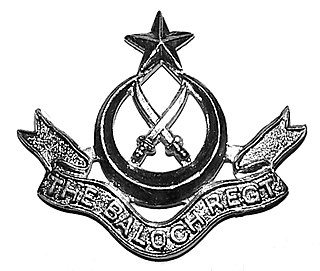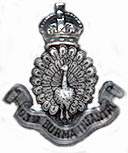
The Baloch Regiment is an infantry regiment of the Pakistan Army. The modern regiment was formed in May 1956 by the merger of 8th Punjab and Bahawalpur Regiments with the Baluch Regiment. Since then, further raisings have brought the strength of the Regiment to 57 active battalions. The Baloch Regiment is descended from the infantry of the old British Indian Army and is named after Balochistan. Before 1991, it was called the Baluch Regiment but the spelling was changed to 'Baloch' to better reflect the correct pronunciation.

The 129th Duke of Connaught's Own Baluchis was an infantry regiment of the British Indian Army raised in 1846 as the 2nd Bellochee Battalion. It was designated as the 129th Duke of Connaught's Own Baluchis in 1903, and became 4th Battalion 10th Baluch Regiment in 1922. In 1947, it was allocated to Pakistan Army, where it continues to exist as 11th Battalion of The Baloch Regiment.

The 8th Punjab Regiment was a regiment of the British Indian Army from 1922 to 1947. It was transferred to Pakistan Army on Partition of India in 1947 and merged with the Baluch Regiment in 1956.

The 10th Baluch or Baluch Regiment was a regiment of the British Indian Army from 1922 to 1947. After the independence, it was transferred to the Pakistan Army. In 1956, it was amalgamated with the 8th Punjab and Bahawalpur Regiments. During more than a hundred years of military service, the 10th Baluch Regiment acquired a distinguished record amongst the regiments of the British Indian Army. Its list of honours and awards includes four Victoria Crosses.

The 62nd Punjabis was an infantry regiment of the British Indian Army. It was raised in 1759 as the 3rd Battalion of Coast Sepoys, and formed part of the Madras Army. It was designated as the 62nd Punjabis in 1903 and became 1st Battalion 1st Punjab Regiment in 1922. In 1947, it was allocated to the Pakistan Army, where it continues to exist as 1st battalion, Punjab Regiment. It is the senior-most surviving infantry battalion of the British Indian Army.

The 84th Punjabis was an infantry regiment of the British Indian Army. It was raised by Captain Donald Macdonald at Vellore on 12 August 1794, as the 34th Battalion of Madras Native Infantry. It was designated as the 84th Punjabis in 1903 and became the 10th (Training) Battalion, 1st Punjab Regiment in 1922. In 1943, it was converted into the 1st Punjab Regimental Centre. In 1947, the 1st Punjab Regiment was allocated to the Pakistan Army. In 1956, the 1st, 14th, 15th and 16th Punjab Regimental Centres where amalgamated to form the Punjab Regimental Centre.

The 89th Punjabis was an infantry regiment of the British Indian Army raised in 1798 as a battalion of Madras Native Infantry. It was designated as the 89th Punjabis in 1903 and became 1st Battalion 8th Punjab Regiment in 1922. In 1947, it was allocated to Pakistan Army, where it continues to exist as 1st Battalion, The Baloch Regiment.

The 90th Punjabis were an infantry regiment of the British Indian Army. The regiment was raised in 1799 as a battalion of Madras Native Infantry. It was designated as the 90th Punjabis in 1903 and became 2nd Battalion 8th Punjab Regiment in 1922. In 1947, it was allocated to Pakistan Army, where it continues to exist as 2nd Battalion of The Baloch Regiment.

The 91st Punjabis was an infantry regiment of the British Indian Army. The regiment was raised in 1800 as a battalion of Madras Native Infantry. It was designated as the 91st Punjabis in 1903 and became 3rd Battalion 8th Punjab Regiment in 1922. In 1947, it was allocated to Pakistan Army, where it continues to exist as 3rd Battalion of The Baloch Regiment.

The 92nd Punjabis were an infantry regiment of the British Indian Army. The regiment was raised in 1800 as a battalion of Madras Native Infantry. It was designated as the 92nd Punjabis in 1903 and became 4th Battalion 8th Punjab Regiment in 1922. In 1947, it was allocated to Pakistan Army, where it continues to exist as 4th Battalion of The Baloch Regiment.

The 130th King George's Own Baluchis was an infantry regiment of the British Indian Army raised in June 1858 as the 1st Belooch Rifles; re-designated as 1st Regiment Jacob's Rifles in September. It was designated as 130th Jacob's Baluchis in 1903 becoming 5th Battalion 10th Baluch Regiment in 1922. In 1947, it was allotted to Pakistan Army, where it continues to exist as 12th Battalion of The Baloch Regiment.
The 126th Baluchistan Infantry was an infantry regiment of the British Indian Army raised in 1825 as the 2nd Extra Battalion of Bombay Native Infantry. It was designated as the 126th Baluchistan Infantry in 1903 and became 2nd Battalion 10th Baluch Regiment in 1922. In 1947, it was allocated to the Pakistan Army, where it continues to exist as 7th Battalion of The Baloch Regiment.

The 124th Duchess of Connaught's Own Baluchistan Infantry was an infantry regiment of the British Indian Army raised in 1820 as the 2nd (Marine) Battalion 12th Regiment of Bombay Native Infantry. It was designated as the 124th Duchess of Connaught's Own Baluchistan Infantry in 1903 and became 1st Battalion 10th Baluch Regiment in 1922. In 1947, it was allocated to Pakistan Army, where it continues to exist as 6th Battalion of The Baloch Regiment.
The 127th Queen Mary's Own Baluch Light Infantry was an infantry regiment of the British Indian Army raised in 1844 as The Scinde Bellochee Corps. It was designated as the 127th Baluch Light Infantry in 1903 and became 3rd Battalion 10th Baluch Regiment in 1922. In 1947, it was allocated to Pakistan Army, where it continues to exist as 10th Battalion of The Baloch Regiment.
The 26th Jacob's Mountain Battery was an artillery unit of the British Indian Army. The battery traces its origins to Golandauze Battalion (1826). In 1843 it became the 10th Company Golandauze Battalion of Bombay Foot Artillery, and became the 26th Jacob's Mountain Battery in 1903. In 1947, it was transferred to the Pakistan Army, where it exists as the 1st Jacob's Battery (Baloch) of The First (SP) Medium Regiment Artillery.

19th Battalion The Baloch Regiment is one of the oldest Light Anti-Tank Regiment of Pakistan Army. Initially raised as the Machine Gun Battalion of 10th Baluch Regiment in 1942, it was first designated as 53rd Regiment, Indian Armoured Corps and then re-designated as 17/10th Baluch. This unit has the unique honour of being the parent unit of Pakistan Army's special forces known as Special Service Group. Prominent officers including General Mirza Aslam Beg, General Pervez Musharraf have served in the unit and Maj Gen Abrar Hussain and Maj Gen Aboobaker Osman Mitha also known as AO Mitha have commanded this unit. Another famous officer was the brilliant Col. S.G. Mehdi, M.C, considered the 'Father of SSG" whose career was cut short when he refused to agree to a foolhardy scheme concocted by the Pakistan Army general Staff to launch para commandos in Indian Held Kashmir in 1965. The Operation called "Gibraltar" was the brainchild of Gen Akhter Malik, whose inordinate ambitions lead to this grand fiasco. Mehdi was sacked and the new commander was ordered to go ahead with the mission which was a total disaster.

The Bahawalpur Regiment was an infantry regiment of Pakistan Army. The regiment was formed in 1952 from the infantry battalions of the erstwhile Princely State of Bahawalpur, which had acceded to Pakistan in 1947. In 1956, the Bahawalpur Regiment was merged with the Baluch Regiment.

The Coorg War was fought between the British East India Company and the State of Coorg in 1834. Defiance of the Raja of Coorg, a small state in South India, led to a short but bloody campaign in 1834. In February 1834, a force of 7000 was assembled under the command of Brigadier General Lindsay to commence operations against the Raja, who had begun hostilities against the British. Due to the poor state of roads, the force was divided into four columns, which were to enter Coorg from different directions and converge on the capital of Mercara. On 11 March, the Northern Division under the command of Colonel Gilbert Waugh entered the territory of Coorg and on 3 April, the leading troops made contact with the enemy. At noon, the advanced guard arrived in front of the fortified position of Soamwar Pettah. The force launched an attack on the position but was forced to retreat after a severe mauling. The leader of the Coorg resistance at was 'Madanta' (Mathanda) Appachu. Similar fate was suffered by another column.
British East Africa 1896 is a Battle Honour awarded to the 24th (Baluchistan) Regiment of Bombay Infantry; an infantry battalion of the British Indian Army, which participated in the 1896 expedition to British East Africa to suppress a local rebellion.
British East Africa 1897–99 is a Battle Honour awarded to 27th Regiment of Bombay (Light) Infantry; an infantry battalion of the British Indian Army, which participated in the 1897 expedition to British East Africa to suppress a rebellion.

















